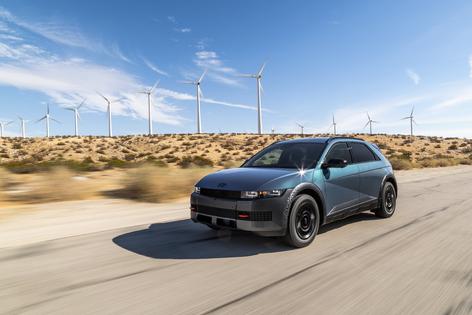Eric's Autos: 2025 Hyundai Ioniq 5 XRT
You've probably seen off-roading Land Rovers and Jeeps with Jerry cans of gas strapped to their sides. The reason for that being that there aren't many gas stations around off-road. So it's interesting to see Hyundai offer an off-road version of the Ioniq 5, which is a compact electric crossover.
It does come standard with a larger/stronger battery pack and more advertised driving range on a full charge.
But what happens if you run low when you're far from a paved road?
What It Is
The Ioniq 5 is a small electric crossover that competes with similar battery-powered models in the same size/price range such as the Ford Mustang Mach-E as well as its in-house cousin, the Kia EV6. It's also a less expensive alternative to the Tesla Model Y.
Two main things distinguish this battery-powered Hyundai from the others. The first is that it's available in a version that does not focus on "ludicrous" acceleration. Quickness takes a backseat to a lower price tag -- and more driving range.
If you want more range -- and quicker acceleration -- it's available.
So also the unique (among battery-powered vehicles) XRT trim, which offers off-road upgrades such as increased ground clearance, a set of all-terrain tires, tow hooks, front and rear clips designed to increase angles of approach and departure and a two-way charging system that can be used to power small appliances when you're nowhere near another place to plug those in.
Prices start at $42,600 for the base SE Standard Range, which comes with a smaller/less powerful battery pack, 168 horsepower and a fully charged driving range of 245 miles. This version of the Ioniq 5 is also rear-wheel drive, which is a big difference versus other non-EV small crossovers -- all of which are front-wheel drive-based.
The $46,650 SE comes with a larger/stronger battery pack, 225 advertised horsepower and up to 318 miles of driving range if you stick with RWD. You can also opt for a dual-motor/all-wheel-drive setup that bumps the power up to 320 horsepower -- at the cost of about 30 miles of advertised driving range. This version of the Ioniq 5 also comes standard with a heat-pump type cabin heating system that draws less energy from the battery.
The $49,600 SEL is also available with the same drivetrain options but adds some features such as power folding side mirrors, synthetic leather seat covers, a heated steering wheel and rear-seat heat ducts.
The $54,300 Limited comes with 20-inch wheels, a panorama sunroof, nicer seats (driver's seat has extendable thigh cushion) and rear sunshades.
What's New for 2025
The off-road themed XRT version of the Ioniq 5 has been addition to the lineup; all trims get an updated interior and a Tesla-style charge plug.
What's Good
-- Home charge cord is included (it's extra-charge in some models, such as the Volkswagen ID. Buzz).
-- Off-road XRT equipment is unusual to find in an electric vehicle.
-- Indicated driving range jibes with how far you can actually drive.
What's Not So Good
-- Rising cost of electricity has pretty much eliminated any "fuel cost" savings.
-- Now that the federal $7,500 tax rebate has expired, buyers will have to pay full price for this (and every other) EV.
-- Charge (range) leakage overnight if you haven't got a place to plug this (or any other) EV in overnight.
Under the Hood
Like most (but not all) EVs, there's a trunk under the hood; this EV's electric powertrain is hidden underneath the floorpans.
The standard drivetrain consists of a single motor driving the rear wheels, powered by a 63 kWh battery pack; this battery pack can store more electricity than the previously standard 58 kWh battery pack and Hyundai says it can be "fast" charged ... faster (from 10% to 80% in about 20 minutes).
The standard drivetrain advertises 168 horsepower and a maximum fully charged driving range of 245 miles.
The optional long-range drivetrain consists of an 84 kWh battery (replacing last year's 77 kWh battery pack) and this increases the Hyundai's advertised driving range to 318 miles for single-motor (RWD) models. If you opt for the available dual-motor setup (which makes this EV AWD) the advertised driving range decreases to 290 miles, but you get 320 horsepower and 446 foot-pounds of torque.
On the Road
Driving the Ioniq 5 was a pleasant surprise because the range indicated turned out to be an underestimate -- for once. I have test-driven many EVs over the past several years -- most of the models that are available -- and all of them did not go as far as indicated. The difference between actual and indicated was typically 10%-20% and when it was very cold out, as much as 30%-40%. It was not very cold (early October) when I test-drove the Ioniq 5, but it did go farther (in actual miles) than the miles-available indicator indicated, by about 5% on the positive side of the ledger. That really matters with an EV -- especially when it's one like the standard-range Ioniq 5 that has a maximum-advertised range of 245 miles.
With its standard (168 horsepower) single-motor/RWD drivetrain, the Ioniq 5 doesn't have the "ludicrous" acceleration capability of a Tesla, but it still responds to your right foot impressively because of the immediacy of the power delivery. It feels quicker from a dead stop than many non-EVs that actually are quicker. That goes for passing power also -- because in an EV, there's no momentary turbo lag, and there's no wait for the transmission to downshift (because there is no transmission; in an EV, the electric motors directly drive the wheels).
With the dual motor setup, "ludicrous" acceleration (0-60 mph in just over four seconds, which would keep pace with most V12 supercars made as recently as the late '90s) is at your beck and call -- though remember that using this performance capability will drain the battery pack just as quickly as making use of a V12 supercar's capability would drain its tank.
At the Curb
The Ioniq 5 is 183.3 inches long, just a little bit smaller overall than its main rival, the Ford Mustang Mach-E (which is 185.6 inches long), so it's not surprising it has less room inside -- for cargo. The Hyundai's got 26.3 cubic feet behind its backseats, and the total available with the backseats folded down is 59.4 cubic feet. The Ford has 34.4 cubic feet behind its backseats and a total of 64.4 cubic feet. The Ford also has more front-seat legroom (43.3 inches versus 41.7 inches) though about an inch and a half less backseat legroom (38.1 inches versus 39.4 inches).
The Ford's base price ($37,995) is also lower, and its standard power (268) is higher. However, the Ford is not available with anything like the XRT equipment that Hyundai offers with the Ioniq 5. This includes the raised suspension mentioned earlier -- plus the knobby tires, tow hooks and a two-way charging system that allows you to power other devices (such as a TV or crock pot or electric lights) to make off-road camping more like off-road glamping.
But be careful about venturing too far off-road (or using too much of the battery's remaining charge to power up your camping accessories) for the obvious reason: There aren't many places to get a charge when you're off-road. Land Rovers and Jeeps can carry Jerry cans of gas. It is not easy to carry extra electricity with you.
The Rest
A thoughtful feature is the state of charge display located by the charge door. It shows -- using illuminated rows of boxes -- how much charge has been recovered at a glance, from outside the vehicle.
The Bottom Line
The Ioniq 5 is an interesting alternative (in XRT trim) to the Mustang Mach-E. It's also thousands less expensive than a Tesla Model Y ($44,990 to start) and can go places the latter can't.
Put another way, it's different -- and for an EV, that's no small praise.
========
Eric's latest book, "Doomed: Good Cars Gone Wrong!" will be available soon. To find out more about Eric and read his past columns, please visit the Creators Syndicate webpage at www.creators.com.
Copyright 2025 Creators Syndicate, Inc.








Comments